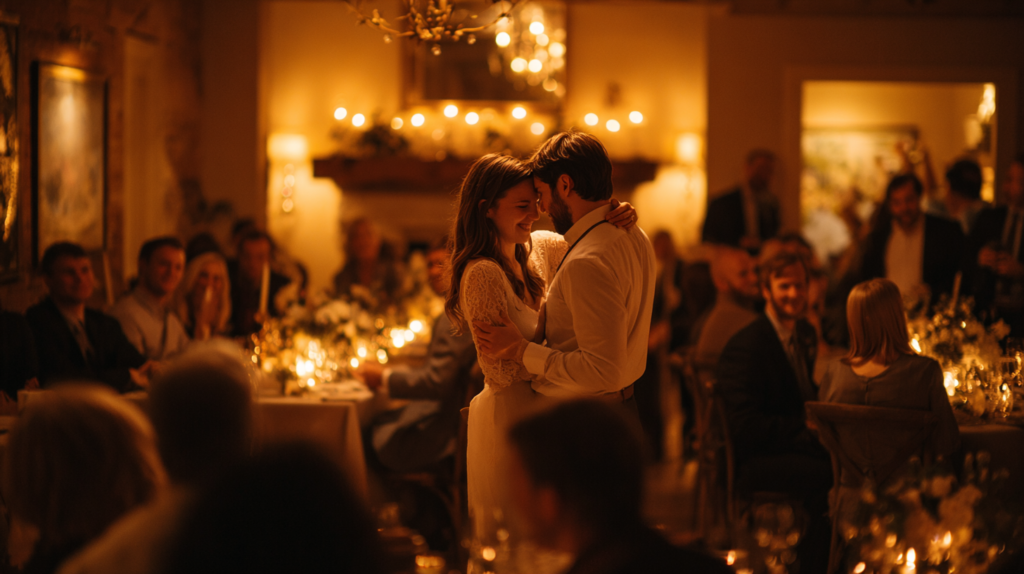Not every wedding takes place in a ballroom. More and more couples are choosing intimate venues — garden courtyards, cosy wine bars, small restaurants, or even backyards — to say “I do.”
While the atmosphere may be warm and magical, these settings often leave little room for one very important moment: your first dance.
If you’re worried about how to move in a tight spot or navigate a sea of guests, these small wedding dance floor tips will help you own your space with confidence, grace, and style.
At Wedding Dance Sydney, we help couples choreograph beautiful, expressive dances tailored to any space — no matter how snug.
1. Know Your Dimensions (Before the Day)
Even a few extra centimetres can make or break your ability to execute a dip or turn. Ask your venue for exact floor dimensions — or better yet, measure it yourself if you can.
Things to clarify:
-
Is the dance floor square, rectangular or round?
-
Is it a dedicated space or temporarily cleared?
-
Will tables, speakers or decor eat into the usable area?
Once we know your space, we’ll tailor your choreography precisely.
2. Keep Your Steps Small and Compact
Forget travelling footwork or sweeping glides. In a tight space, less really is more.
We recommend:
-
Close-in, grounded steps
-
Stationary turns and gentle side steps
-
Minimal spins and no lifts (unless planned with precision)
-
Emphasis on timing, rhythm and body positioning
These moves look elegant and feel natural in small areas.
3. Use the Edges Strategically
You don’t have to stay in the centre. Moving toward the edge, turning toward a guest cluster, or rotating around a focal point (like a column or cake table) adds visual interest and maximises your space.
We choreograph routines with purposeful rotation so your audience gets a dynamic view — even from tight angles.
4. Practise in a Similar Space
If your venue isn’t accessible before the big day, rehearse at home in a comparable area. Tape off a space in your lounge room or garage to mimic the floor’s size and shape.
This helps you:
-
Get comfortable with spacing
-
Refine arm movements
-
Avoid overextending or underestimating transitions
At Wedding Dance Sydney, we often simulate venue layouts in our studio for rehearsal purposes.
5. Avoid Floor-Crowding Elements
Watch out for:
-
Table corners too close to the dance floor
-
Low-hanging chandeliers
-
Portable speaker setups
-
Floral arrangements or candles on the ground
Let your planner or venue coordinator know you need 100% clear space for dancing — even if it’s just 2.5 x 2.5 metres.
6. Match the Music to the Space
Choose a song with a tempo and energy that feels appropriate for a compact setting.
Ideal choices:
-
Romantic acoustic ballads
-
Jazz or swing with a tight rhythm
-
Light indie pop with a bouncy beat
We’ll help you pick (or edit) your song so that it supports small-scale choreography beautifully.
7. Use Emotion, Not Size, to Fill the Room
You don’t need to cover every corner to make an impact. What guests remember most is how you made them feel.
Focus on:
-
Eye contact
-
Sincere smiles
-
Intentional movement
-
Moments of stillness and breath
We design routines where intimacy becomes the performance — not how many spins you squeeze in.
Conclusion
Don’t let limited square footage limit your moment. With the right choreography, song selection and spatial awareness, your first dance can be as breathtaking in a tiny courtyard as it would be in a ballroom.
At Wedding Dance Sydney, we create bespoke routines for all venue sizes — so you can feel relaxed, confident and connected, no matter how much room you have to move.
Because magic doesn’t come from space — it comes from presence.
FAQ
Yes, absolutely. Even a 2.5 x 2.5 metre space can accommodate a beautiful, well-choreographed routine. We design steps and movements that work perfectly for small or narrow floors.
Songs with a slower tempo and emotional tone tend to work well. Acoustic tracks, jazz standards, or indie ballads are great choices that suit close, contained movement.
Not necessarily — but they need to be carefully planned. In smaller venues, we may modify or reduce the range of movement to keep things safe and elegant without feeling restricted.
Recreate the floor at home by taping off the dimensions in your living room or backyard. Practise your full routine within that area to get used to the constraints.
Not at all. With the right posture, expression and flow, even minimal movement can look intentional and polished. We’ll help you turn constraints into creativity.
Yes. Guests are more moved by connection and emotion than choreography complexity. A heartfelt performance in a small space can feel incredibly intimate and unforgettable.
Speak to your planner or venue manager ahead of time to ensure the floor remains clear. Even a tiny buffer zone helps avoid crowding and makes dancing feel more comfortable.
We may simplify or adjust certain moves, but that doesn’t mean it’ll be less impressive. In fact, small-space routines often feel more elegant and grounded when executed smoothly.
Yes. They may need to adjust speaker placement or lighting. We also recommend providing your song version early so they understand the pacing and tone that suits your venue.
Absolutely. We’ve worked with everything from courtyard cafés to rooftop terraces. Our team tailors every routine to your exact venue size and layout for maximum impact.
